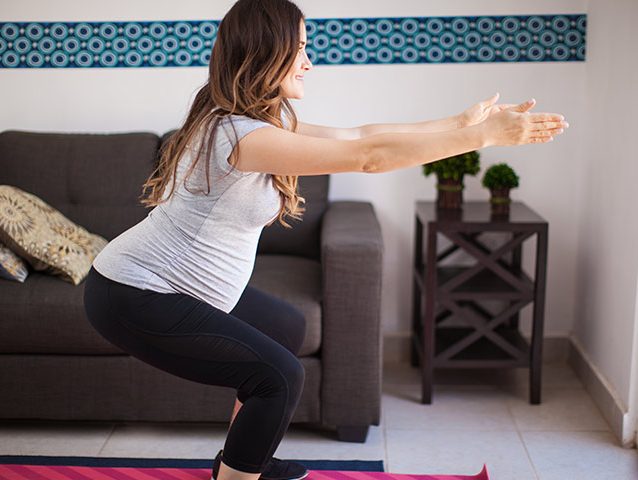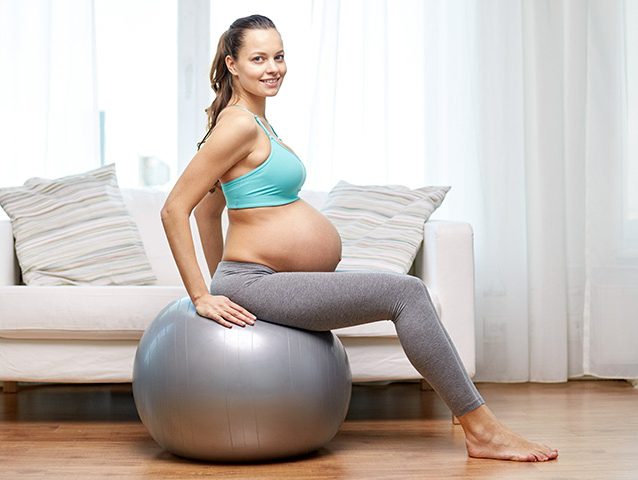9 Best Exercises To Induce Labor Naturally
Labor is perhaps the most challenging stage of pregnancy.
The approaching due date and the unending thoughts about the pain, the baby’s health, and your health can give you panic attacks. But it doesn’t have to be that way.
Did you know that the labor pain can be eased and the process of delivery can be smooth and easy with certain movements and positions that prepare you for labor? Yes, there are certain exercises that can help make the labor process smooth.
In this MomJunction post, we tell you about a few such exercises to support labor naturally. Read on.
Exercises To Facilitate Labor Naturally
Before you try any of the exercises for labor, it is imperative that you talk to your doctor about it. You can also consult a fitness coach who is an expert in prenatal fitness.
Below are a few exercises that you can try to facilitate a smooth vaginal delivery/ labor. Always make sure you have an assistant or expert with you while you are doing them:
The approaching due date and the unending thoughts about the pain, the baby’s health, and your health can give you panic attacks. But it doesn’t have to be that way.
Did you know that the labor pain can be eased and the process of delivery can be smooth and easy with certain movements and positions that prepare you for labor? Yes, there are certain exercises that can help make the labor process smooth.
In this MomJunction post, we tell you about a few such exercises to support labor naturally. Read on.
Exercises To Facilitate Labor Naturally
Before you try any of the exercises for labor, it is imperative that you talk to your doctor about it. You can also consult a fitness coach who is an expert in prenatal fitness.
Below are a few exercises that you can try to facilitate a smooth vaginal delivery/ labor. Always make sure you have an assistant or expert with you while you are doing them:
1. Pelvic rocks:

These exercises help pregnant women descend the baby through the birth canal. According to research, the pelvic rocks help in managing pain, improving focus and labor process, and offering utmost satisfaction with the delivery.
Pelvic rocks or pelvic tilts can be practiced in various ways that include standing pelvic tilts with a chair, lying on the back, seated tilts, and passive tilts with a partner’s help.
How to do it:
Standing pelvic tilts:
Lying on the back:
Pelvic rocks on a ball (seated):
Ensure you have someone to support you through these exercises.
2. Leaning:

This form of exercise will help you relieve the pressure on the pelvic area, which has tissues and muscles supporting your bladder and uterus . Leaning exercises can give your baby some extra space to move inside the pelvis. Also, they enable you to rest a little during labor.
How to do it:

This is considered to be one of the most effective and safe exercises to facilitate labor. It strengthens the pelvic muscles and opens up the pelvic area, thereby making it easier for the baby to move down the birthing canal. Also, regular deep squats can relax the muscles and stretch the perineum.

It is one of the most common methods to induce labor. This is a gravity positive exercise that strengthens the contractions and leads to active labor .
A word of caution:
5. Kegel exercises:

These exercises are effective for strengthening the pelvic floor. During pregnancy, muscles in the pelvic region tend to become loose, resulting in loss of incontinence and discomfort. Practicing Kegel exercises regularly will keep the muscles relaxed while you are in labor. Also, these exercises help you learn how to control your muscles during labor.
How to do it:

The butterfly exercise offers plenty of benefits to pregnant women. It reduces fatigue, stretches the knees and thighs, and enhances flexibility in the groin and hip region. Practicing this exercise regularly during pregnancy will help you have a smooth delivery .
How to do it:
7. Lunges:
A lunge is proven to be an effective position or exercise to reduce the pain and enable movement of the baby. Also, it helps the mother with contractions and eases the way down for the baby .
A word of caution: Always have a helper while you are performing lunges so that you are not out of balance.
Lunges can be done in different ways, the common ones being standing lunges and kneeling lunges.
How to do it:
Standing lunges:

Kneeling lunges:

8. Stair climbing:

One of the exercises that make the delivery process simpler is climbing stairs. It is considered helpful for safe and smooth delivery .
A word of caution: Do not put extra pressure on your body while climbing stairs. Make sure you are climbing the floors slowly and steadily. And if you have someone by your side, it would be convenient.

Exercising with a ball is a recommended, inexpensive, non-pharmacological, and helpful strategy for normal delivery. There are many ball exercises to prepare your body for a smooth delivery. However, it is essential to be careful at every step while you are having fun trying this.
Some other benefits of ball exercises during pregnancy are improved flexibility, resistance, and strength, along with maintained balance in the quadriceps and lower back area. Furthermore, you can practice dozens of ball exercises to induce labor.
How to do it:
Bouncing on the ball:
While all these exercises are suggested for safe labor, there are certain conditions when pregnant women should not exercise.
Who Shouldn’t Exercise To Facilitate Labor?
If you have any of the below-mentioned conditions, then you are advised to consult an expert or a doctor before trying the exercises to induce labor.
Women who have been prescribed complete bed rest should not exercise. Their condition is considered critical, hence professional opinion on exercising is a must.
If you have a condition named placenta previa, then you need to avoid exercises as they may cause complications .
Although there is no evidence suggesting that exercises may be harmful in the case of a twin pregnancy, it is better to seek a doctor’s advice before practicing exercises to induce labor.
If you are experiencing amniotic fluid leakage, then it is better to avoid exercises as it could be unsafe .
Pregnant women who have a history of premature labor need to limit or avoid any physical activity to prevent the risks of complications during delivery. In case you want to practice low-impact exercises, consult your doctor.
If you have a condition called cervical insufficiency, then exercises to induce labor are not recommended.

These exercises help pregnant women descend the baby through the birth canal. According to research, the pelvic rocks help in managing pain, improving focus and labor process, and offering utmost satisfaction with the delivery.
Pelvic rocks or pelvic tilts can be practiced in various ways that include standing pelvic tilts with a chair, lying on the back, seated tilts, and passive tilts with a partner’s help.
How to do it:
Standing pelvic tilts:
- Arrange a solid chair to practice this exercise
- Hold the backside of the chair in a standing position, with your elbows straight
- Bend slowly and push your hips towards the back
- Hold for about 10 seconds and then pull forward
- Repeat the same for a couple of times. Make sure your abdominal muscles are in a relaxed state and buttocks are tightened when you do
- You can try this exercise by standing against a wall too.
Lying on the back:
- Lie on the back with your feet on the floor and knees folded
- Slightly move your pelvis to the front and hold for few seconds
- Now relax and come to the start position
- In case you feel light-headed, or there is discomfort, you can stop the workout
Pelvic rocks on a ball (seated):
- Arrange a Swiss ball or exercise ball
- Sit on the ball, tuck your tailbone and roll forward
- Then get back to the starting position and roll the ball with your tailbone
- Keep repeating several times for about five minutes.
Ensure you have someone to support you through these exercises.
2. Leaning:

This form of exercise will help you relieve the pressure on the pelvic area, which has tissues and muscles supporting your bladder and uterus . Leaning exercises can give your baby some extra space to move inside the pelvis. Also, they enable you to rest a little during labor.
How to do it:
- You can do this by leaning on anything: it could be on a ball, a wall, a table, or even your partner
- You need to lean by exerting pressure on your back
- Practicing this exercise several times would make your delivery easier

This is considered to be one of the most effective and safe exercises to facilitate labor. It strengthens the pelvic muscles and opens up the pelvic area, thereby making it easier for the baby to move down the birthing canal. Also, regular deep squats can relax the muscles and stretch the perineum.
Squats can prepare the body naturally for childbirth, provided you perform them right.
How to do it:
How to do it:
- Stand straight with your feet apart and keep your shoulders straight
- Lower your body by bending the knees, while ensuring that your back is straight
- It is better if you have someone to hold you and help you with the balance
- Hold the squat position for about 20 to 30 seconds and come back to the standing position
- Repeat it several times a day

It is one of the most common methods to induce labor. This is a gravity positive exercise that strengthens the contractions and leads to active labor .
A word of caution:
Do not walk more than what you should to jump-start the labor, as exhausting yourself could diminish your energy that would be required during labor and childbirth. Remember, your baby will come out only when they are ready.
5. Kegel exercises:

These exercises are effective for strengthening the pelvic floor. During pregnancy, muscles in the pelvic region tend to become loose, resulting in loss of incontinence and discomfort. Practicing Kegel exercises regularly will keep the muscles relaxed while you are in labor. Also, these exercises help you learn how to control your muscles during labor.
How to do it:
- Identification of the pelvic floor muscles is the first and the most important step. You can figure it out by sitting on the toilet seat and trying to hold your urine. The muscles you tighten are the pelvic floor muscles.
- Once you know, hold or tighten the muscles for about 5 to 10 seconds and slowly release.
- Do not tighten your thighs or buttocks while practicing it
- Start with three to five Kegels a day, and you can increase the number gradually.
- Ten Kegels a day is an ideal number to target.

The butterfly exercise offers plenty of benefits to pregnant women. It reduces fatigue, stretches the knees and thighs, and enhances flexibility in the groin and hip region. Practicing this exercise regularly during pregnancy will help you have a smooth delivery .
How to do it:
- Sit down with your legs straight and spine erect
- Bend your knees in a way that your soles touch one another, and slowly bring them towards your pelvis region.
- Hold your feet in position, keeping your spine straight
- Now breathe in and breathe out, and start flapping your knees slowly
- Keep taking long breaths and feel your inner thighs stretching. This will relax your muscles
- Finally, release your legs and come to the start position.
7. Lunges:
A lunge is proven to be an effective position or exercise to reduce the pain and enable movement of the baby. Also, it helps the mother with contractions and eases the way down for the baby .
A word of caution: Always have a helper while you are performing lunges so that you are not out of balance.
Lunges can be done in different ways, the common ones being standing lunges and kneeling lunges.
How to do it:
Standing lunges:

- Image: Shutterstock
- Stand straight, keeping your back erect
- Hold your partner’s hand to maintain a balance
- Now, take one foot to the front and lunge. Hold for three to five seconds and come back to the starting position
- Do the same with another leg. And repeat the process for about three to five times a day.
Kneeling lunges:

- You can do these on your bed, but make sure to have a helper by your side
- Start with kneeling on both legs
- Now lift one leg and keep the foot down on the bed
- Hold for five seconds and come back to the start position
- Lunge on both sides and repeat the process.
8. Stair climbing:

One of the exercises that make the delivery process simpler is climbing stairs. It is considered helpful for safe and smooth delivery .
A word of caution: Do not put extra pressure on your body while climbing stairs. Make sure you are climbing the floors slowly and steadily. And if you have someone by your side, it would be convenient.
9. Ball exercises:

Exercising with a ball is a recommended, inexpensive, non-pharmacological, and helpful strategy for normal delivery. There are many ball exercises to prepare your body for a smooth delivery. However, it is essential to be careful at every step while you are having fun trying this.
Some other benefits of ball exercises during pregnancy are improved flexibility, resistance, and strength, along with maintained balance in the quadriceps and lower back area. Furthermore, you can practice dozens of ball exercises to induce labor.
How to do it:
- Rolling on the ball:
- Sit on the ball and gently start rolling by making circles with the ball
- When you roll your pelvis region, it will relax your hip and lower back muscles
- Do not rush or hasten, but be slow while rolling the ball to stay safe
Bouncing on the ball:
- Sit on the ball, and slowly bounce on it
- This movement will help your baby to descend
- You can also try a squatting position with the help of a ball
While all these exercises are suggested for safe labor, there are certain conditions when pregnant women should not exercise.
Who Shouldn’t Exercise To Facilitate Labor?
If you have any of the below-mentioned conditions, then you are advised to consult an expert or a doctor before trying the exercises to induce labor.
Women who have been prescribed complete bed rest should not exercise. Their condition is considered critical, hence professional opinion on exercising is a must.
If you have a condition named placenta previa, then you need to avoid exercises as they may cause complications .
Although there is no evidence suggesting that exercises may be harmful in the case of a twin pregnancy, it is better to seek a doctor’s advice before practicing exercises to induce labor.
If you are experiencing amniotic fluid leakage, then it is better to avoid exercises as it could be unsafe .
Pregnant women who have a history of premature labor need to limit or avoid any physical activity to prevent the risks of complications during delivery. In case you want to practice low-impact exercises, consult your doctor.
If you have a condition called cervical insufficiency, then exercises to induce labor are not recommended.








No comments: